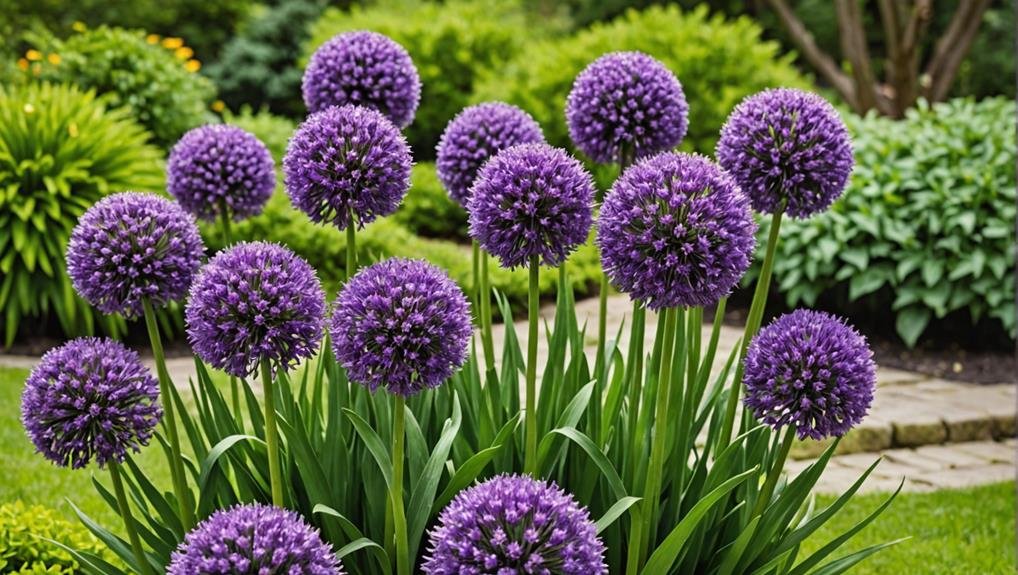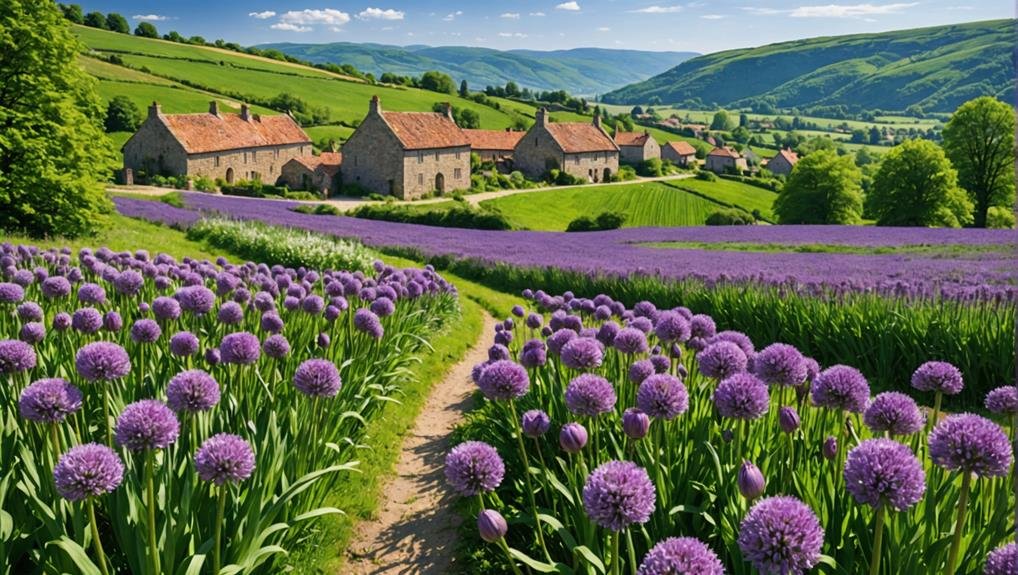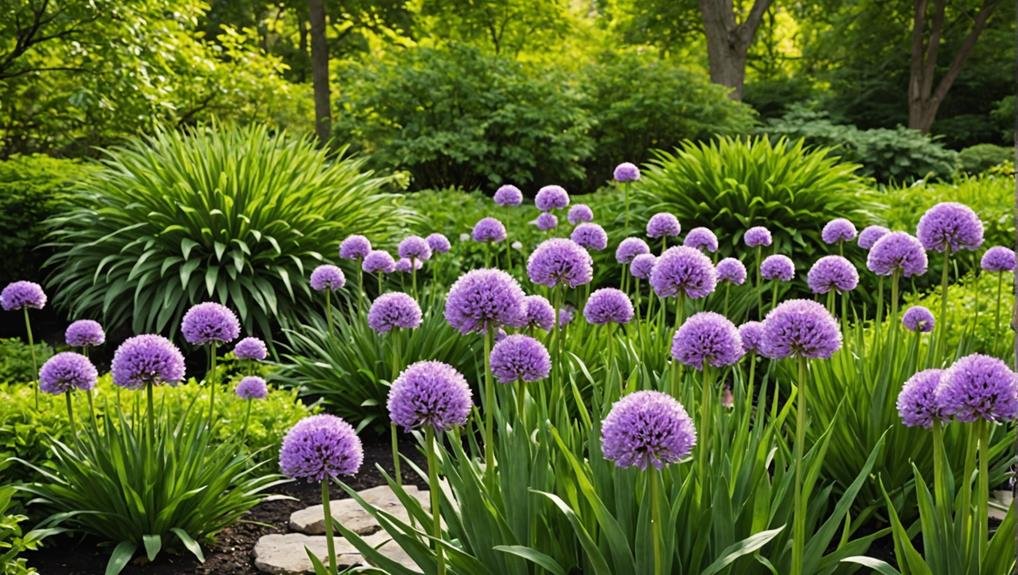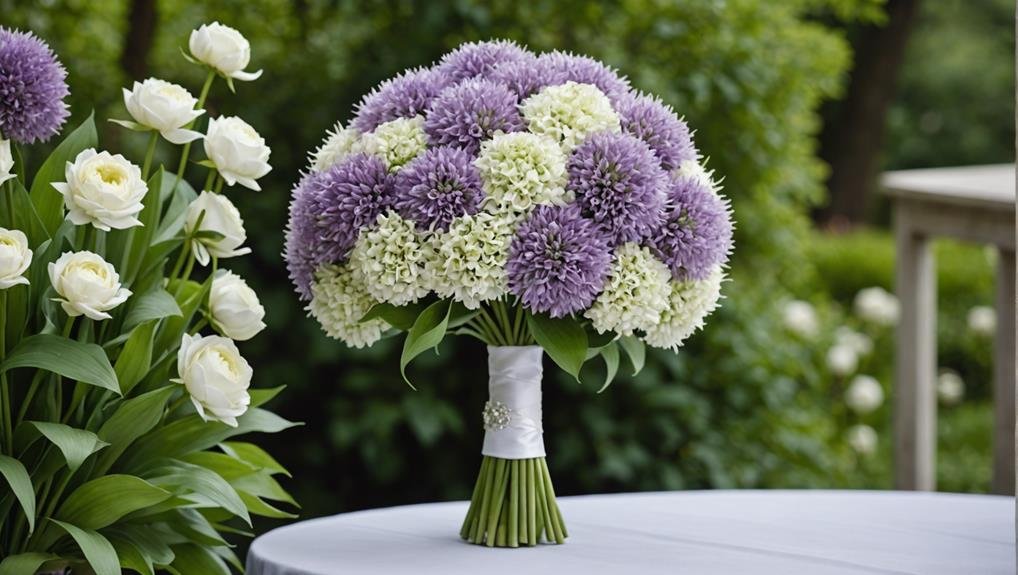The allure of Allium flowers in wedding arrangements is undeniable, given their unique spherical clusters and range of stunning colors including purple, white, pink, and yellow. These blooms, known scientifically as part of the Allium genus, offer both aesthetic charm and symbolic richness, representing unity and prosperity. With over 400 varieties, each with a vase life extending up to three weeks, they provide a versatile option for various floral designs. Understanding their geographical origins, growing conditions, and cultural significance can greatly enhance their use in creating memorable wedding decor. This guide will explore these aspects in detail.
Flower Overview

Renowned for their spherical clusters of small, star-shaped blossoms, alliums are commonly referred to as ornamental onion flowers. These flowers are increasingly gaining popularity in wedding floral designs due to their unique appearance and vibrant colors. Allium flowers are celebrated for their shades of purple, which can range from deep violet to light lavender, providing a versatile palette for various wedding themes.
Alliums are not only visually appealing but also a practical choice for wedding arrangements. Their vase life ranges from 10 days up to 3 weeks, ensuring that they remain fresh and beautiful throughout the wedding festivities. This longevity makes them a cost-effective option for brides and florists alike. Fresh alliums are ideally used when one-third to one-half of their blossoms are open, ensuring the best freshness and visual impact.
The versatility of alliums extends beyond their color variations. With over 400 varieties available, these flowers can seamlessly blend into different floral designs, adding both texture and depth. Additionally, the sweet scent of certain varieties, such as Allium neopolitanum, enhances the sensory experience, making allium flowers a delightful addition to any wedding bouquet or centerpiece.
Physical Description
Allium flowers display dense, spherical clusters of small, star-shaped blooms that create a striking visual impact. These clusters form a round shape, lending a unique and appealing aesthetic to floral arrangements. Mainly observed in shades of purple and white, these flowers bloom in late spring, making them a popular choice for weddings and other seasonal events.
Each flower head consists of numerous tiny florets, tightly packed together to form a globe-like structure. This physical description highlights the intricate and delicate nature of alliums, which are available in various types, each offering a distinct charm. The blossoms typically open from the top down, ensuring a gradual and extended display of color and texture.
The flowers stand atop tall, slender stems, which further accentuate their spherical form. Allium neopolitanum, a notable variety, is distinguished by its sweet scent, adding an aromatic dimension to its visual appeal. Despite their slight onion scent when damaged, the allure of their flower heads remains undiminished.
With over 400 varieties, alliums provide a diverse range of options for floral designers. Their longevity, lasting up to three weeks, guarantees that they remain a vibrant part of any arrangement throughout an event's duration.
Available Colour Varieties

A diverse range of shades, including purple, white, pink, and yellow, enhances the versatility of Allium flowers in floral arrangements. Each color variety brings its unique charm, making Allium an excellent choice for various wedding themes and styles. Among the most popular are the vibrant purple hues, found in varieties like Purple Sensation and Gladiator. These striking shades add depth and drama to any bouquet or centerpiece.
White Allium flowers, such as those seen in Allium nigrum, offer a crisp, clean appearance, ideal for elegant and sophisticated settings. The pink varieties, though less common, provide a soft, romantic touch, blending seamlessly with other pastel-colored blooms. Yellow Allium, while rarer, introduces a cheerful and sunny element to floral designs, perfect for spring or summer weddings.
In addition to their color diversity, Allium flowers are known for their distinctive structural features. Varieties like Allium christophii are celebrated for their starburst appearance, creating a dynamic visual impact. Allium giganteum, on the other hand, forms impressive globular clusters that serve as stunning focal points in any arrangement.
The wide range of vibrant hues and unique shapes guarantees that Allium flowers can meet the creative needs of any floral designer.
Latin Name and Taxonomy
The Latin name for ornamental onion flowers is Allium, which belongs to the diverse Allium genus within the Amaryllidaceae family. This taxonomic classification highlights the botanical complexity and rich diversity of this group of flowers.
The Allium genus encompasses over 400 varieties, each distinguished by their spherical clusters of small, star-shaped blossoms. These blossoms range in color from vibrant purples and whites to delicate pinks and yellows, contributing to their popularity in floral arrangements.
The Allium genus is part of the broader Amaryllidaceae family, which includes other well-known ornamental and edible plants. Taxonomically, Alliums are notable for their slight onion scent, a characteristic more pronounced when the blossoms are damaged. Notably, Allium neopolitanum stands out within the genus for its sweet scent, making it particularly suitable for cut flower arrangements due to its pleasant aroma.
Understanding the taxonomy of Alliums is essential for horticulturists and florists alike, as it provides insights into the care, cultivation, and application of these beautiful flowers. Their vase life ranges from 10 days to 3 weeks, making them a durable choice for wedding bouquets and other floral displays.
Geographical Origins

Native to the northern hemisphere, ornamental onions thrive in diverse regions such as Europe, Asia, and North America. These perennial bulbous plants have found their niche in a variety of climates and soils, making them a versatile choice for gardeners and florists alike.
The geographical origins of Allium are intriguing and diverse:
- Europe: Many species of Allium, including the popular Allium Sphaerocephalon, are indigenous to Europe. The continent's temperate climate and fertile soils provide ideal conditions for these plants to flourish.
- Asia: Asia boasts a rich diversity of Allium species, thanks to its varied landscapes and climates. Countries like China and Japan are particularly notable for their unique Allium varieties, contributing to their global popularity.
- North America: In North America, native Allium species have adapted to a range of environments, from the cool climates of Canada to the warmer regions of the United States. This adaptability makes them a resilient choice for cultivation.
- Perennial Bulbous Plants: As perennial bulbous plants, Alliums are well-suited to return year after year, providing consistent beauty in gardens and wedding arrangements.
Understanding the geographical origins of Allium enhances our appreciation for these versatile and enduring ornamental onions.
Season Availability
Understanding the seasonal availability of Alliums is important for planning elegant and timely wedding floral arrangements. Typically, Alliums are available from late spring through summer, making them a popular choice for weddings and events during these months.
The availability of Allium can vary based on the specific variety chosen. For instance, Allium Sphaerocephalon has an extended availability from June to December, providing more flexibility for event planners looking to incorporate this unique flower into their designs.
It is important to take into account the season when selecting Alliums to make sure they are in peak condition. Knowing the peak availability times of different Allium varieties can help in making informed decisions for floral arrangements. For most Allium varieties, the peak season aligns with late spring and summer, which coincides with the high season for weddings and outdoor events.
Growing Conditions

Alliums are remarkably sturdy flowers that can thrive in a variety of growing conditions, including poor or dry soil. These adaptable blooms are known for their durability and ease of cultivation, making them an excellent choice for avid gardeners and florists alike. Alliums can tolerate both sunny and shaded areas, providing versatility in their placement.
When considering their incorporation into wedding flowers, it is crucial to note that specific Allium varieties such as White, Purple, Lavender, and Purple/Burgundy are available. These varieties can reach four to six feet in height, making them ideal for dramatic floral displays.
To guarantee the best growth and longevity, consider the following guidelines:
- Soil Conditions: Alliums thrive in poor or dry soil, reducing the need for constant watering.
- Sunlight: These flowers flourish in both sunny and shaded areas, but ensure tall varieties are planted in wind-protected spots.
- Vase Life: Alliums have a long-lasting vase life of 10 days up to 3 weeks, making them practical for wholesale or loose sprays.
- Companions: As part of the onion and garlic family, Alliums can deter pests, benefiting surrounding plants.
Incorporating Alliums into wedding arrangements not only adds aesthetic appeal but also guarantees resilience and longevity.
Cultural Significance
Across various cultures, Alliums hold deep symbolic meanings, representing unity, prosperity, and good fortune. These attributes stem from the flower's round, globe-like shape, which symbolizes completeness and harmony. This cultural significance has allowed Alliums to reach a broad audience, making them a popular choice in various ceremonial and celebratory contexts.
European folklore adds another layer to the Allium's appeal by attributing magical properties to these visually delightful flowers. Historically, they were believed to ward off evil spirits and bring good luck to households. This folklore has contributed to their enduring popularity and cultural resonance.
Among the different varieties, Allium neopolitanum stands out not just for its cultural importance but also for its sweet scent, making it ideal for cut flower arrangements. The vibrant hues of Allium flowers, ranging from purple to white, pink, and yellow, further enhance their visual and symbolic appeal.
For those seeking Wholesale Flowers, the Allium's long vase life—ranging from 10 days to 3 weeks—and its availability from late spring through summer make it an excellent choice.
Incorporating Alliums into floral arrangements adds not only aesthetic beauty but also layers of engaging content and insightful commentary on their rich cultural heritage.
Typical Use in Weddings

In the world of wedding floristry, Alliums are infrequently chosen due to their distinct onion-like odor, which can be off-putting in such intimate settings. Despite their striking visual appeal, the unpleasant odor often deters couples from incorporating them into their wedding flower arrangements. Typically, wedding flower guides recommend alternative blooms that offer more pleasant fragrances suitable for matrimonial celebrations.
While Alliums might not be the first choice for traditional weddings, they do find their place in contemporary and modern wedding designs. Couples looking for unique and alternative blooms might consider Alliums for their bold spherical blooms and structural elegance. However, it is essential to weigh the aesthetic benefits against the potential discomfort caused by their scent.
Here are some typical uses of Alliums in weddings:
- Centerpieces: Alliums can be striking in modern table arrangements, adding height and visual interest.
- Bouquets: They can serve as focal points in bouquets, especially when combined with other fragrant flowers to mask their odor.
- Aisle Décor: Used sparingly along the wedding aisle to create a contemporary ambiance.
- Backdrop Designs: Ideal for creating dramatic backdrops that capture attention without overwhelming the senses.
Alternative Flower Types
For couples seeking alternatives to Alliums, popular wedding flower options include roses, peonies, hydrangeas, and dahlias, each chosen for their aesthetic appeal and pleasant fragrance.
Roses are a timeless choice for weddings, symbolizing love and romance. They are available in a wide range of colors, making it easy to match any wedding theme. The beauty and fragrance of roses make them a staple in bridal bouquets and centerpieces.
Peonies, renowned for their large, lush blooms, bring a sense of elegance and romance to wedding decor. Their soft, full petals and delightful fragrance make them a favorite for brides seeking a luxurious floral arrangement.
Hydrangeas are celebrated for their voluminous clusters of flowers and come in a variety of colors, from subtle pastels to vibrant hues. These flowers add texture and depth to wedding arrangements, creating a visually stunning display.
Dahlias, with their intricate petal patterns and wide color palette, offer a unique alternative. Their structural beauty and varied textures can enhance the overall aesthetic of wedding floral designs.
Each of these flowers—roses, peonies, hydrangeas, and dahlias—brings its own unique charm, making them excellent choices for creating memorable and beautiful wedding floral arrangements.
